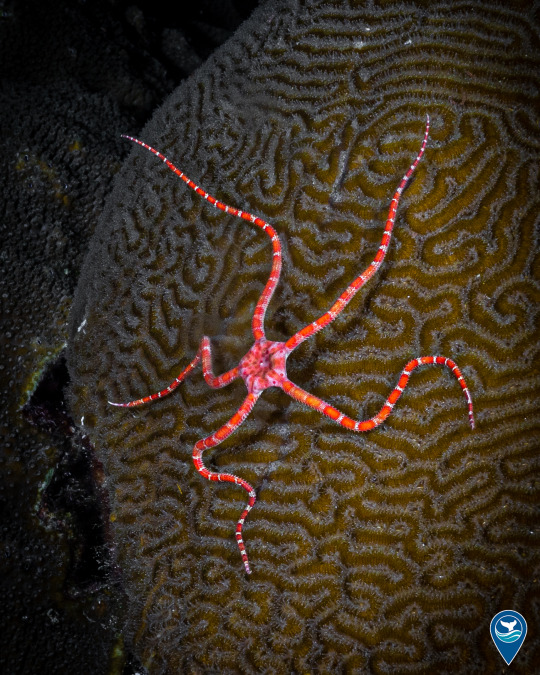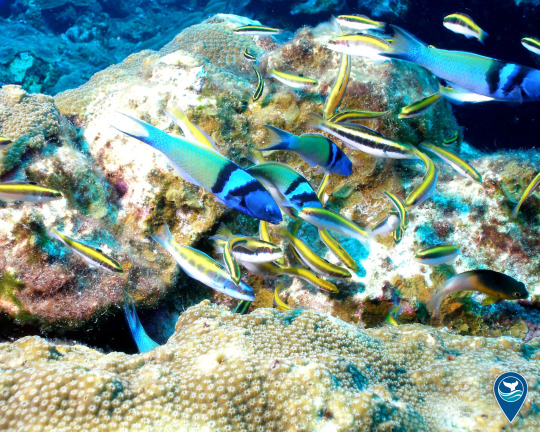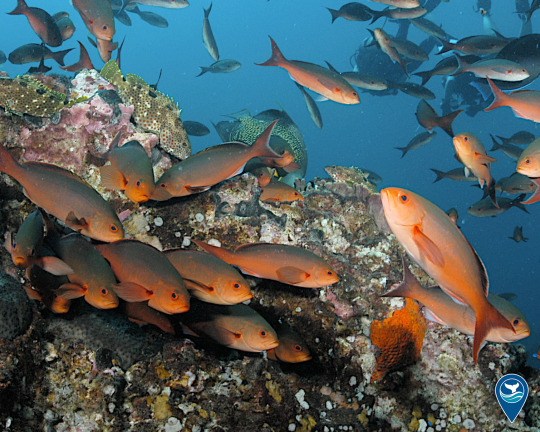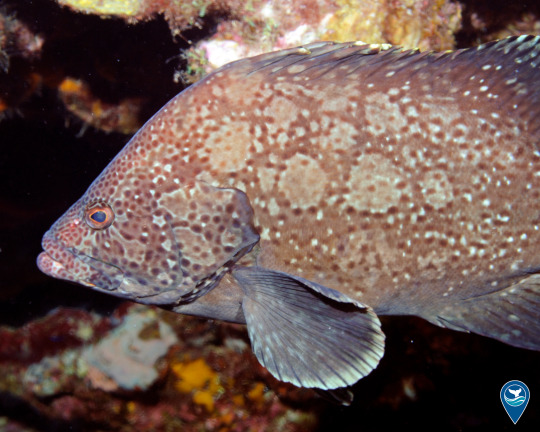#FlowerGardenBanks
Explore tagged Tumblr posts
Text

There’s no place like home, there’s no place like home 👠👠
You said ruby brittle star, not ruby slippers? Oops. Well, this ruby brittle star's home is in Flower Garden Banks National Marine Sanctuary.
This unique species adds a splash of vibrant color to the ocean floor with its striking reddish hue. Like all brittle stars, it has a central disk with long, flexible arms. This species of echinoderm, found in the Western Atlantic, can grow to a maximum size of 21 inches in diameter. When threatened, it can shed its arms as a distraction, allowing the brittle star to escape from predators. Remarkably, it can regenerate lost arms, showcasing an impressive ability to adapt and survive in its challenging underwater environment. Regenerative abilities differ greatly among sea star species.
📸: Jennifer Ackerman (2022 Get Into Your Sanctuary Photo Contest)
89 notes
·
View notes
Photo

@marinesanctuary: One fish, two fish, red fish, blue fish! Check out this breathtaking reef scene in @FGBNMS. We love how vibrant life is in #FlowerGardenBanks. What's your favorite thing about this underwater treasure? #DiscoverWonder 📸: Steve Miller https://t.co/R9blAiYseF
0 notes
Text

Speechless. Just speechless.
Who loves our new 50th Anniversary #SaveSpectacular of Flower Garden Banks National Marine Sanctuary? 😍
NOAA's Flower Garden Banks National Marine Sanctuary encompasses 17 reefs and banks located approximately 80–125 miles off the Texas and Louisiana coasts. These banks are a combination of small underwater mountains, ridges, troughs, and hard-bottom features formed as a result of dynamic salt domes beneath the seafloor. The habitats associated with these banks range from thriving coral reefs and coral communities, to deeper mesophotic reefs filled with black corals, octocorals, algal nodules, and sponges. These varied habitats provide havens for reef fish and invertebrates, as well as manta rays, sea turtles, and sharks.

Take a look for yourself, and download the poster today!
🎨: Kathryn Robertson, Matt McIntosh/NOAA, and Melissa Cook
#FlowerGardenBanks#Texas#Louisiana#MarineLife#CoralReef#GraphicDesign#Art#Illustration#DigitalArt#ocean#noaa#earthisblue#national marine sanctuary#science#nature#conservation
34 notes
·
View notes
Text






The inspiration behind our upcoming #SaveSpectacular commemorative poster 😍
Which Flower Garden Banks National Marine Sanctuary species is your favorite? See these cool critters featured in our new poster that will be released in early December.
1: Bluehead wrasse (Credit: Emma Hickerson/NOAA)
2: Brittle sea star (Credit: G.P. Schmahl/NOAA)
3: Christmas tree worms (Credit: G.P. Schmahl/NOAA)
4: Blue angelfish (Credit: G.P. Schmahl/NOAA)
5: Creolefish (Credit: G.P. Schmahl/NOAA)
6: Marble grouper (Credit: G.P. Schmahl/NOAA)
#EarthIsBlue#FlowerGardenBanks#MarineLife#Underwater#SaveSpectacular#national marine sanctuary#science#nature#ocean#conservation#noaa#diving
43 notes
·
View notes
Text

Blenny for your thoughts?
What do you think this blenny fish in Flower Garden Banks National Marine Sanctuary is thinking? 🤔
Congratulations to Justin Wallace for receiving an honorable mention for his macro shot submission to the Sanctuary Life category of our 2022 Get Into Your Sanctuary Photo Contest.
Check out the rest of this year’s winners:
#EarthIsBlue#MarineLife#FlowerGardenBanks#UnderwaterPhotography#science#nature#ocean#noaa#national marine sanctuary#diving#conservation
155 notes
·
View notes
Text

Yellowheaded jawfish come out of their burrows and gracefully “dance” around waiting for food. When threatened, they quickly retreat to their burrows and will poke their head out slowly to see if the coast is clear 👀
(Image description: a white and yellow elongated fish emerges vertically from a burrow in the seafloor. Photo: G.P. Schmahl/NOAA)
#animalbehavior#reeffish#wildlife#FlowerGardenBanks#Banks#UnderwaterBanks#SanctuaryBanks#EarthIsBlue#Ocean#SeaLife
279 notes
·
View notes
Text

Recreate Responsibly in national marine sanctuaries! 🤿
Congratulations to Roger Veteto for receiving an honorable mention in the Sanctuary Recreation category of our 2022 Get Into Your Sanctuary Photo Contest.
Check out the rest of this year’s winners:
#EarthIsBlue#MarineLife#FlowerGardenBanks#UnderwaterPhotography#RecreateResponsibly#noaa#ocean#nature#national marine sanctuary#conservation#diving
30 notes
·
View notes
Text

What exactly does a research ecologist do, and what type of experience is helpful to someone interested in pursuing such a career? Find out these answers and more by checking out our career profile on NOAA Research Ecologist Michelle Johnston!
"Being able to scuba dive and see the beautiful coral reef that NOAA is responsible for protecting is incredible, but I also enjoy outreach and sharing information about this special place." --Michelle Johnston, Research Ecologist at Flower Garden Banks National Marine Sanctuary
Learn more: https://sanctuaries.noaa.gov/news/mar22/women-in-ocean-careers/profiles.html
Image description: a person scuba diving and holding a collection bag with a lionfish inside. Credit: Ryan Eckert
#WomensHistoryMonth#WomenInScience#WomenInSTEM#scientist#researcher#ecologist#ecology#FlowerGardenBanks#Banks#UnderwaterBanks#SanctuaryBanks#coralresearch#careers#ocean#oceancareers#STEMcareers
57 notes
·
View notes
Text

If he’s green and so shy, with two jaws and two eyes, that’s a moray! 🎶
A green moray eel at Flower Garden Banks National Marine Sanctuary to be exact. Did you know that the green moray eel is actually brown in color? They have a yellow mucus covering their bodies, which blends together to make that beautiful vibrant green we all know and love!
Photo Credit: G.P. Schmahl/NOAA - A green moray eel greets a diver from the safety of its burrow nestled amongst the coral.
#FlowerGardenBanks#Banks#UnderwaterBanks#SanctuaryBanks#McGrailBank#Fish#Ocean#Nature#wildlifephotography#wildlife#EarthIsBlue#photooftheday#Conservation#Science#earthisblue#noaa#ocean#nature#cute#science#national marine sanctuary#marine sanctuary#diving#they look like they just told a joke and are waiting for you to get it
106 notes
·
View notes
Text

We're sharing some of our favorite Women's History Month features from recent years. Last year's web story ""Women of the Water"" shares the story of past, present, and pioneering female ocean scientists.
Read all about it here: https://sanctuaries.noaa.gov/news/mar21/women-of-the-water.html
Image: Scientists from the Sea Turtle Lab at the NOAA Galveston Facility — Michelle Johnston (left) and Marissa Nuttall (right) - release a rehabilitated juvenile hawksbill into the wild. (NOAA)
#FlowerGardenBanks#Banks#UnderwaterBanks#SanctuaryBanks#McGrailBank#texas#Galveston#Ocean#Nature#EarthIsBlue#Conservation#earthisblue#noaa#ocean#nature#science#national marine sanctuary#marine sanctuary#diving
48 notes
·
View notes
Text

Talk about camouflage!
Can you spot the spotted scorpionfish staring right at you? If you have keen eyes, you might come across this fish while diving on Flower Garden Banks National Marine Sanctuary in the Gulf of Mexico. Their mottled coloring and odd texture help them blend in with the reef so they can sneak up on prey like small fish and crustaceans, then swallow them in one fast gulp!
Description: Scorpionfish stares at the camera surrounded by algae and rock. (Photo: Emma Hickerson/NOAA)
#FlowerGardenBanks#Banks#UnderwaterBanks#SanctuaryBanks#McGrailBank#ocean#EarthIsBlue#science#nature#earthisblue#noaa#national marine sanctuary#hiding in plain sight
61 notes
·
View notes
Text

Have you ever seen black coral before?
This species of coral is a colonial organism that produces a branched or unbranched skeletal axis that is similar in appearance to that of gorgonian corals. Species from both groups are commonly referred to as sea fans, sea bushes, sea feathers, or sea whips. Learn more about black coral and the research surrounding them: https://sanctuaries.noaa.gov/news/oct20/changing-tides.html (Photo: GFOE/NOAA. Image description: Alderdice Bank with a feather black coral, a sea whip coral, and reef butterfly fish.)
#FlowerGardenBanks#Banks#UnderwaterBanks#SanctuaryBanks#AlderdiceBank#Corals#Feather#BlackCoral#SeaWhip#ButterflyFish#Texas#TX#Louisiana#ROV#Diving#earthisblue
81 notes
·
View notes
Text

Muh-muh-muh-ma-muh-muh-ma-muh-ma! Man(ta) Ray!
Today we are celebrating #WorldMantaDay! Manta rays are popular visitors to Flower Garden Banks National Marine Sanctuary and can reach 22 feet from fin-tip to fin-tip. Join us in the festivities by learning more about them: https://sanctuaries.noaa.gov/magazine/5/flower-garden-banks/. (Photo: Beata Lerman. Image description: A manta ray from above with two remoras on the back.)
#EarthIsBlue#Manta#MantaRay#ManRay#FlowerGardenBanks#GulfOfMexico#Texas#Louisiana#Magazine#Education#Ocean#Rays
107 notes
·
View notes
Text
NOAA Awards $1.7 Million for Habitat Connectivity Research to Support National Marine Sanctuaries

Understanding how different ocean and coastal habitats are connected to each other and how fishes, marine mammals, seabirds, and sea turtles use them is the focus of three newly funded projects in Florida Keys National Marine Sanctuary, Flower Garden Banks National Marine Sanctuary, and Stellwagen Bank National Marine Sanctuary.

This month, NOAA National Centers for Coastal Ocean Science is announcing $1.7 million of an anticipated $5.9 million in funding for research to support the management of national marine sanctuaries!

Read the full story: https://sanctuaries.noaa.gov/news/oct21/habitat-connectivity.html.
#Habitat#FloridaKeys#StellwagenBank#FlowerGardenBanks#NCCOS#MPAs#MPA#FFO#FederalFundingOpportunity#Fish#Turtles#HarborSeal#MarineMammals
63 notes
·
View notes
Text
youtube
Seahorses are fish with unique features that allow them to thrive on McGrail Bank in Flower Garden Banks National Marine Sanctuary!
Learn all about this special creature in our #EarthIsBlue video.
#EarthIsBlue#Seahorses#seahorse#FlowerGardenBanks#Sanctuary#NOAA#Ocean#Gulf of Mexico#Gulf#Texas#Louisiana#Coastal#underwater banks#banks#azealia banks#Youtube
28 notes
·
View notes
Photo

Hitching a free ride into the weekend like...
Remoras and manta rays have what scientists call a mutualistic relationship, where both organisms benefit from each other. Remoras cling to the body of the ray, catching a free ride, food scraps, and increased protection. All the while, the manta ray enjoys a spa treatment as the remoras clean its skin of parasites and bacteria. Talk about giving new meaning to, ""I've got your back!""(Photo: Beata Lerman. Image description: Manta ray from above with two remoras on either side of its body.)
#EarthIsBlue#Symbiotic#MantaRay#Ray#GulfOfMexico#Remora#FreeRide#SpaDay#FlowerGardenBanks#TexasCoast
198 notes
·
View notes